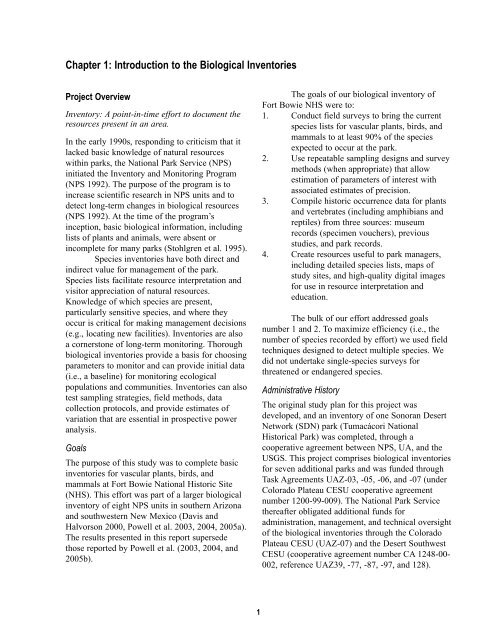Download this report as a 94-page PDF - USGS
Download this report as a 94-page PDF - USGS
Download this report as a 94-page PDF - USGS
Create successful ePaper yourself
Turn your PDF publications into a flip-book with our unique Google optimized e-Paper software.
Chapter 1: Introduction to the Biological Inventories<br />
Project Overview<br />
Inventory: A point-in-time effort to document the<br />
resources present in an area.<br />
In the early 1990s, responding to criticism that it<br />
lacked b<strong>as</strong>ic knowledge of natural resources<br />
within parks, the National Park Service (NPS)<br />
initiated the Inventory and Monitoring Program<br />
(NPS 1992). The purpose of the program is to<br />
incre<strong>as</strong>e scientific research in NPS units and to<br />
detect long-term changes in biological resources<br />
(NPS 1992). At the time of the program’s<br />
inception, b<strong>as</strong>ic biological information, including<br />
lists of plants and animals, were absent or<br />
incomplete for many parks (Stohlgren et al. 1995).<br />
Species inventories have both direct and<br />
indirect value for management of the park.<br />
Species lists facilitate resource interpretation and<br />
visitor appreciation of natural resources.<br />
Knowledge of which species are present,<br />
particularly sensitive species, and where they<br />
occur is critical for making management decisions<br />
(e.g., locating new facilities). Inventories are also<br />
a cornerstone of long-term monitoring. Thorough<br />
biological inventories provide a b<strong>as</strong>is for choosing<br />
parameters to monitor and can provide initial data<br />
(i.e., a b<strong>as</strong>eline) for monitoring ecological<br />
populations and communities. Inventories can also<br />
test sampling strategies, field methods, data<br />
collection protocols, and provide estimates of<br />
variation that are essential in prospective power<br />
analysis.<br />
Goals<br />
The purpose of <strong>this</strong> study w<strong>as</strong> to complete b<strong>as</strong>ic<br />
inventories for v<strong>as</strong>cular plants, birds, and<br />
mammals at Fort Bowie National Historic Site<br />
(NHS). This effort w<strong>as</strong> part of a larger biological<br />
inventory of eight NPS units in southern Arizona<br />
and southwestern New Mexico (Davis and<br />
Halvorson 2000, Powell et al. 2003, 2004, 2005a).<br />
The results presented in <strong>this</strong> <strong>report</strong> supersede<br />
those <strong>report</strong>ed by Powell et al. (2003, 2004, and<br />
2005b).<br />
1<br />
The goals of our biological inventory of<br />
Fort Bowie NHS were to:<br />
1. Conduct field surveys to bring the current<br />
species lists for v<strong>as</strong>cular plants, birds, and<br />
mammals to at le<strong>as</strong>t 90% of the species<br />
expected to occur at the park.<br />
2. Use repeatable sampling designs and survey<br />
methods (when appropriate) that allow<br />
estimation of parameters of interest with<br />
<strong>as</strong>sociated estimates of precision.<br />
3. Compile historic occurrence data for plants<br />
and vertebrates (including amphibians and<br />
reptiles) from three sources: museum<br />
records (specimen vouchers), previous<br />
studies, and park records.<br />
4. Create resources useful to park managers,<br />
including detailed species lists, maps of<br />
study sites, and high-quality digital images<br />
for use in resource interpretation and<br />
education.<br />
The bulk of our effort addressed goals<br />
number 1 and 2. To maximize efficiency (i.e., the<br />
number of species recorded by effort) we used field<br />
techniques designed to detect multiple species. We<br />
did not undertake single-species surveys for<br />
threatened or endangered species.<br />
Administrative History<br />
The original study plan for <strong>this</strong> project w<strong>as</strong><br />
developed, and an inventory of one Sonoran Desert<br />
Network (SDN) park (Tumacácori National<br />
Historical Park) w<strong>as</strong> completed, through a<br />
cooperative agreement between NPS, UA, and the<br />
<strong>USGS</strong>. This project comprises biological inventories<br />
for seven additional parks and w<strong>as</strong> funded through<br />
T<strong>as</strong>k Agreements UAZ-03, -05, -06, and -07 (under<br />
Colorado Plateau CESU cooperative agreement<br />
number 1200-99-009). The National Park Service<br />
thereafter obligated additional funds for<br />
administration, management, and technical oversight<br />
of the biological inventories through the Colorado<br />
Plateau CESU (UAZ-07) and the Desert Southwest<br />
CESU (cooperative agreement number CA 1248-00-<br />
002, reference UAZ39, -77, -87, -97, and 128).

















